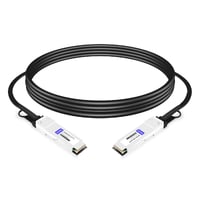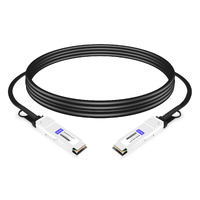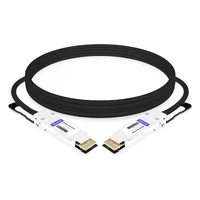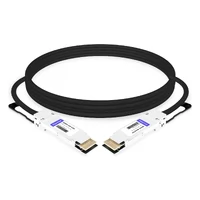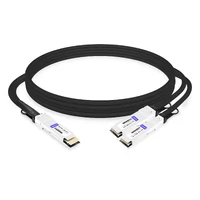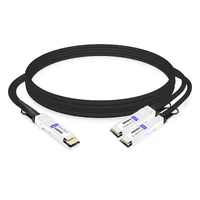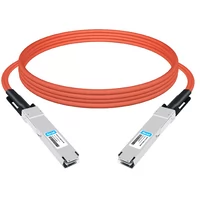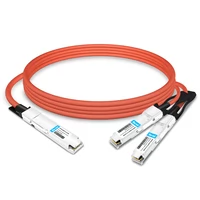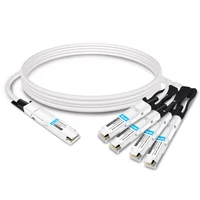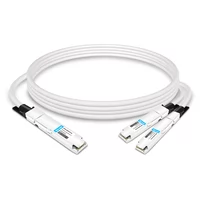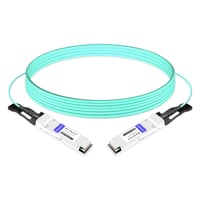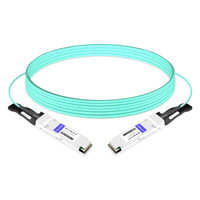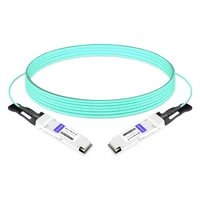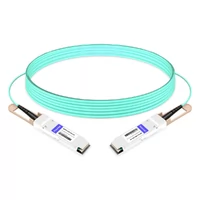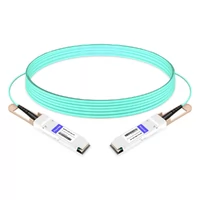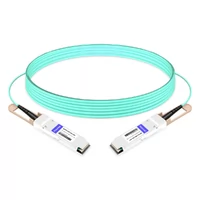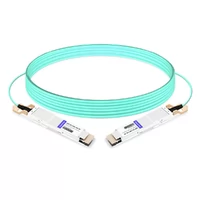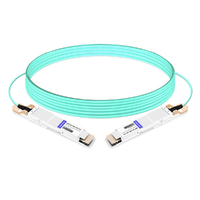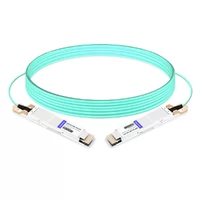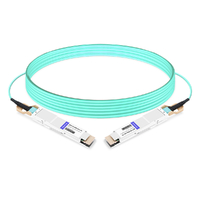Today, when it comes to data centers, it is important to have convenient and stable connectivity for better performance and uninterrupted running. Direct Attach Copper (DAC) cables and Active Optical Cables (AOC) are two main components that help attain this goal. These wires are used to improve data transmission between servers, switches, storage systems, and other devices within the data center. Depending on specific demands or limitations of a given environment, each type of cable has its own benefits and disadvantages too. What follows is an analysis of what sets DAC apart from AOC, including their use cases plus considerations for selection by IT experts. This way, operators will be able to grow networks efficiently while making informed choices so that they can scale them as much as possible to fit their needs.
Table of Contents
ToggleWhat is a DAC Cable in Data Centers?
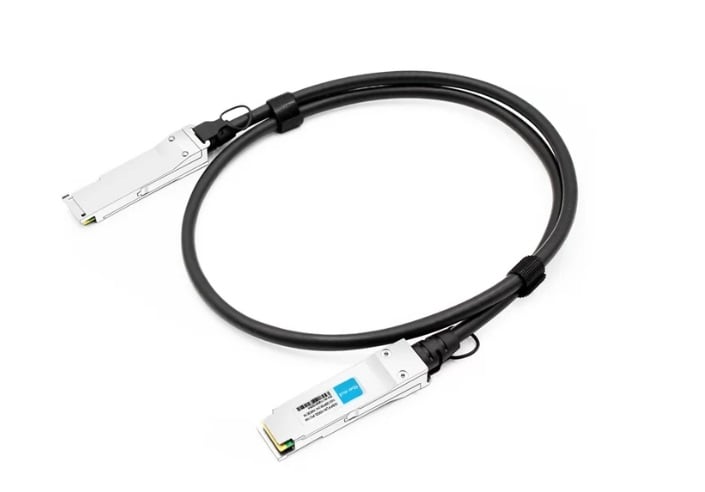
The Basics of Direct Attach Cable
Direct Attach Cable (DAC) is a copper cable that has transceivers attached at its two ends. DAC cables are widely used in data centers for short-distance connections and usually vary in length from 1 to 7 meters. These cables are famous for their low latency, high reliability, and cost-effectiveness, which makes them ideal for interconnecting servers or switches within racks or adjacent racks. There are passive and active DAC variants; passive DACs have signal processing electronics while active ones do not; hence, they consume less power and can only be used over short distances due to their simplicity. Active DACs, on the other hand, support longer lengths by having signal processing electronics that help to maintain signal integrity throughout the transmission distance.
How DAC Cables Work
Direct attach cables are used for data transmission through differential signaling in which two wires transport identical signals at opposite voltage levels. This minimizes electromagnetic interference and enhances the quality of the signal. Typically, passive DAC cables exploit only the intrinsic properties of copper conductors to ensure efficient short-haul data transfer, usually limited to 5 meters. Conversely, active DACs have built-in circuitry that amplifies and conditions the signal, thus allowing them to support longer distances — sometimes even up to 10 meters — while still maintaining high performance with minimal delay. Because they are plug-and-play devices, no extra power supply is needed, nor are there any complicated settings required for their implementation.
Types of DAC Cables
- Passive DAC Cables: Passive connections are cheap and simple; they don’t have any signal conditioning circuitry. They are typically used for short-range applications up to 5 meters. These wires are best suited for cost-effective installations because they consume less power and are simpler in design.
- Active DAC Cables: Signal integrity is enhanced by electric components integrated into active cables while allowing for longer distances. Latency remains low as they can stretch over 10 meters or beyond without compromising on it. Therefore, these types of wires should be employed where high performance is required over greater distances.
- Variations of QSFP and SFP: Different form factors exist for DAC cables, with QSFP (Quad Small Form-Factor Pluggable) and SFP (Small Form-Factor Pluggable) being the most common ones. For fast 40GbE and 100GbE links, use QSFP DACs, while SFP DACs support 1GbE to 10GbE connections. Depending on network equipment’s port configurations as well as performance needs, these differentiations allow one to choose among them freely.
What is an Active Optical Cable?
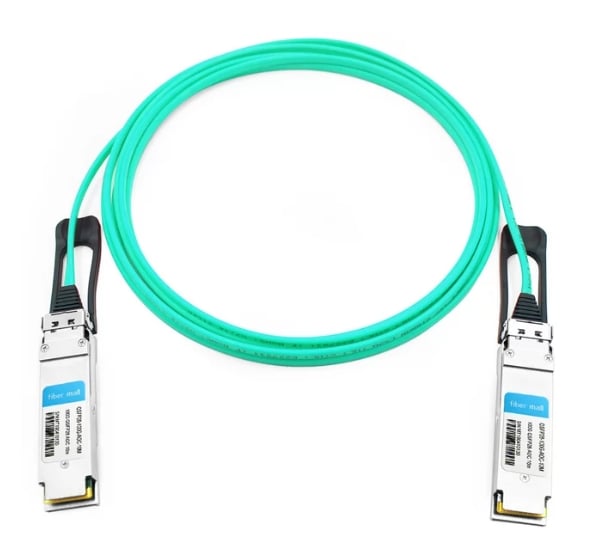
Introduction to Active Optical Cable
An active optical cable (AOC) is a type of cabling that employs optical fiber instead of traditional copper wiring for high-speed data transmission. In contrast to direct-attach copper (DAC) cables, which use electrical signals for sending information between devices, AOCs use light to transmit data at higher bandwidths over longer distances. Developed to prevent signal deterioration across extended spans, these cables provide low electromagnetic interference and cross-talk reduction. Hence they are particularly useful in hyperscale environments or other situations where signal integrity must be maintained over significant lengths.
How AOC Cables Operate
Active Optical Cables (AOCs) convert electrical signals into optical ones and can, therefore, send data much faster over larger distances than traditional copper wiring. The main parts of AOCs are the optical transceivers that are attached at both ends of the cable and the fiber-optic cable itself. Here’s how AOC cables work:
- Transmitter Module: This part has a laser diode which changes an incoming electrical signal into an optical one. It encodes light pulses with the electrical input from a device then sends them through an optic fiber.
- Optical Fiber: Usually made from plastic or glass, this is what makes up most of any given active optical cable. The fiber optic core guides these long-distance light pulse transmissions between transmitters and receivers, hardly losing any signal power. This is done thanks in no small part to material characteristics such as high bandwidth capacity coupled with low attenuation rates.
- Receiver Module: At one end, there is usually another module called the receiver; it contains, among other things, an optic detector (often a photodiode) that captures arriving light pulses before converting them back into electric currents or signals again – readying them for processing elsewhere downstream if need be.
- Signal Integrity: One of the key features of active optical cables is their ability to maintain signal integrity over long distances. Optical transmission inherently resists electromagnetic interference (EMI) and crosstalk more effectively than copper-based systems, which have common grounding points for multiple devices along their length. This ensures higher-quality data transfers while reducing bit error rates (BER).
- Power Consumption: Although some electricity needed by embedded transceivers within each end point still may result in lower overall power usage when compared against equivalent copper solutions designed specifically for use over extended reaches such as those found within data centers thereby making active optics cables more energy efficient.
Technical Data on AOC Performance
- Data Rates: Upwards 400Gbps can be supported with different applications ranging from 10Gbps Ethernet up to beyond 100Gbps standards.
- Distance: Standard active optical cables can transmit over a maximum distance of around one hundred meters, although some specialized versions can go even further than this.
- Latency: Low latency is achieved using optical transmission, which is ideal for environments where high speeds are required.
- Temperature Range: Active optic cables operate best within broad temperature ranges, usually between negative five degrees Celsius and seventy degrees Celsius; thus, they are highly reliable in different environmental conditions.
It’s clear to see why AOCs have become such an important part of modern networks and data centers – by taking advantage of light-based technology, these devices enable fast long distance communication.
Benefits of Using Active Optical Cables
- Higher Data Rates and Bandwidth: Active Optical Cables (AOCs) provide better data rates and wider bandwidths than conventional copper cables. They can reach speeds of up to 400Gbps, thus are ideal for high performance computing and data intensive applications.
- Longer Distance Reach: AOCs have the capability to transmit over long distances without much signal loss as one of their major benefits. For normal cases the transmission distance handled by standard AOCs is 100 meters but there are versions that can go beyond this limit.
- Immune to Electromagnetic Interference: EMI or crosstalk which are common problems with copper cabling do not affect AOCs at all since they have natural immunity to such interferences. This feature enables reliable transmission of data thereby ensuring high integrity levels are maintained throughout.
- Lower Power Consumption: Energy-wise, it is more efficient using AOCs than copper cables, especially when dealing with longer spans where the latter requires lots of power for its transceivers. In other words, even though embedded transceivers require power over lengthy distances, less is consumed, making this type suitable for large-scale networking setups within data centers.
- Light Weightness and Flexibility: Comparing the weights of these two types clearly shows that active optical cable is much lighter than its counterpart, copper cable. Thus, it makes the installation process simpler and reduces the load on infrastructure components at the same time. Moreover, the flexibility exhibited by these wires enhances good cable management practices within data centers.
- Improved Dependability plus Sturdiness: Typically operating in a temperature range of -5°C to 70°C, active optical wires have been made strong enough that they can work efficiently under harsh environmental conditions; this makes them reliable even after being used for quite some time in different areas.
Key Differences between DAC and AOC Cables
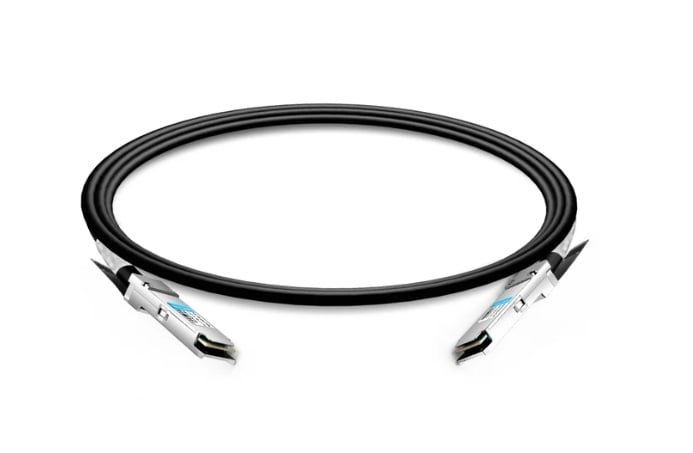
Differentiating Direct Attach Cables and Active Optical Cables
- Distance of Transmission: Direct Attach Cables (DACs) commonly have a limited transmission range which is usually not more than 10 meters; however, Active Optical Cables (AOCs) have the capability to cover up to 100m or even more.
- Quality of Signal: DACs are vulnerable to signal degradation and electromagnetic interference, but AOCs can resist these problems, thereby ensuring data integrity at longer distances.
- Power Consumption: Over short distances, DACs consume less power as compared to AOCs which are energy-efficient for long-distance transmissions though they require power for transceivers.
- Installation and Management: Lightweight and flexible, AOCs simplify installation and cable management, while DACs are heavier and less flexible.
- Strength and Environmental Adaptability: As far as durability is concerned, AOCs are made stronger so that they can withstand wide temperature ranges, whereas this is not the case with DACs that operate in relatively narrow environmental conditions.
Cable Length Considerations: AOC vs DAC
When you think about the length of the cable, DAC is the most suitable for short distance application, which is typically below 10m thus making it ideal for inter-rack or intra-rack connections. On the contrary, AOC can support much longer distances that often exceed 100m, hence making it more appropriate for inter-building or large data center connections. Additionally, AOCs are also flexible, which makes it easy to install and manage cables over extended lengths, while DACs, on the other hand, are rigid and may have difficulties under similar distances. Therefore, you should choose either AOCs or DACs based on specific distance and environmental requirements in a given deployment scenario.
Data Rate: DAC vs AOC
While looking at data rates, both Direct Attach Cables (DACs) and Active Optical Cables (AOCs) are strong, but they have different performances when used for various applications and distances. Usually, DACs can handle data speeds of up to 400 Gbps which makes them a good choice for high-speed connections within shorter ranges in data centers. Nonetheless, their ability declines with distance due to signal attenuation. In contrast with this, AOC uses similar data rate support through the use of optical fiber technology that maintains excellent performance even over long distances, sometimes beyond 100 meters, thus making them more suitable where high amounts of information must be transmitted fast and far while ensuring uniformity of signal strength without getting affected by electromagnetic interferences as it may happen with DACs. Therefore, you should select either DAC or AOC depending on how far apart things are situated as well as what kind of speed is needed at every point in your network design architecture.
When Should You Use AOC Cables in Your Data Center?
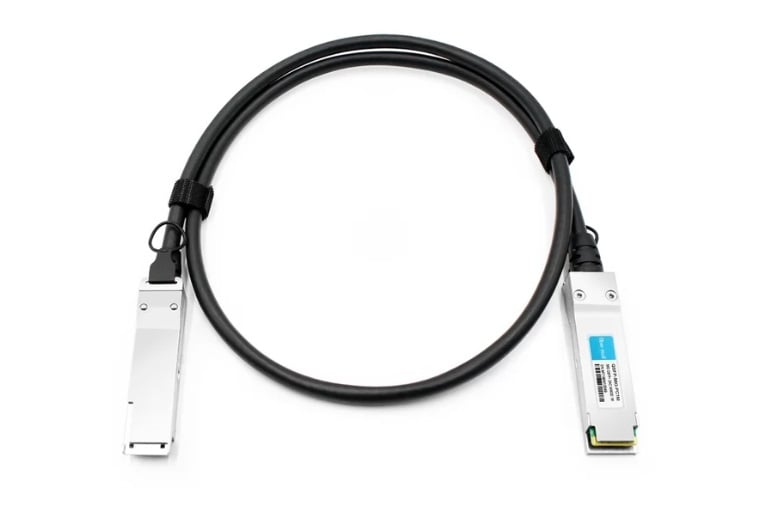
Advantages of Active Optical Cables
- Expanded Coverage: AOCs are able to cover more than 100 meters, which makes them perfect for connecting buildings that are far apart or in different parts of the same large data center.
- Faster Data Transfer Rates: They can transfer data at a speed of up to 400 Gbps while still maintaining good performance over long distances.
- Less Electromagnetic Interference: This feature ensures that there is no electromagnetic disturbance; hence, the quality of the signals is always maintained.
- More Versatility: Their flexibility allows for easier installation and cable management, especially when working with longer cables.
- Better Signal Quality: The use of optical fiber technology in AOCs guarantees higher signal integrity compared to extended copper cables where degradation occurs.
Specific Use Cases for AOC Cables
- Inter-Data Center Connectivity: AOCs are highly efficient in connecting distinct data centers and/or buildings within a spacious yard, particularly where range and signal integrity are crucial.
- High-Performance Computing Clusters: AOCs are used in high-performance computing environments to facilitate fast node-to-node data transfer with minimum latency.
- Cloud Service Providers: These are the best options for cloud service providers that need dependable connections with enormous bandwidth to sustain various cloud-based services and applications.
- Storage Area Networks (SANs): SANs require AOCs that maintain high quality signals across them thus ensuring efficient processes of storing and retrieving data.
- Network Switches and Routers: They can be utilized for establishing quick links between network switches and routers resulting to enhanced performance in complicated network topologies.
Assessing Cable Needs in Data Centers
To guarantee good performance and scalability, it is important to consider a number of factors when determining cable requirements in data centers. Below are some of the key areas that need to be assessed:
- Bandwidth: Establish the current and future bandwidth demands of the facility. This means that cables should have high data rates which can be supported by AOC (Active Optical Cable) or DAC (Direct Attach Copper) among others because high-performance applications require them as well as increased traffic.
- Distance: Evaluate how far apart different parts of the center are located physically relative to each other and what distance will be covered by wires while transferring information between these points. In situations where longer distances have to be covered, for example, between buildings within a campus setting, optical fiber-based solutions like AOCs would work best due to their strong signal integrity, even over long lengths with minimum attenuation.
- Cable Density and Airflow: When dealing with highly populated environments, it is necessary to plan carefully so as not to congest everything together but rather allow enough ventilation around them. The design should include thinner cords, which can easily bend, rather than thicker ones. This would enhance proper cooling through effective cable management, thus slimming down on energy wastage associated with excessive heat generation.
- Future Proofing—Considerations need also be made about growth prospects and technological advancements projected for the DC. Scalable infrastructure investments enable easy upgrades without necessarily disrupting existing systems greatly or destroying already laid-out foundations altogether during subsequent expansions.
- Budget Constraints: Balance between performance expectations vis-à-vis available funds since fiber optics provide superior performance besides being future-proof proof; hence, it is recommended where applicable from short-term perspectives up to lower speed connections across limited spaces.
These are just a few considerations when carrying out such an assessment; however, many more could always exist depending on the specific circumstances surrounding each particular data center establishment.
Please refer to other sources like Cisco, Arista Networks, and Center Dynamics for deeper insight and the most recent developments in line with contemporary DC needs. Other sources provide comprehensive guidelines based on current industry best practices that cater to various aspects of data center operations, including security and power management, among others (Cisco, Arista Networks & Datacenter Dynamics).
When Should You Use DAC Cables in Your Data Center?
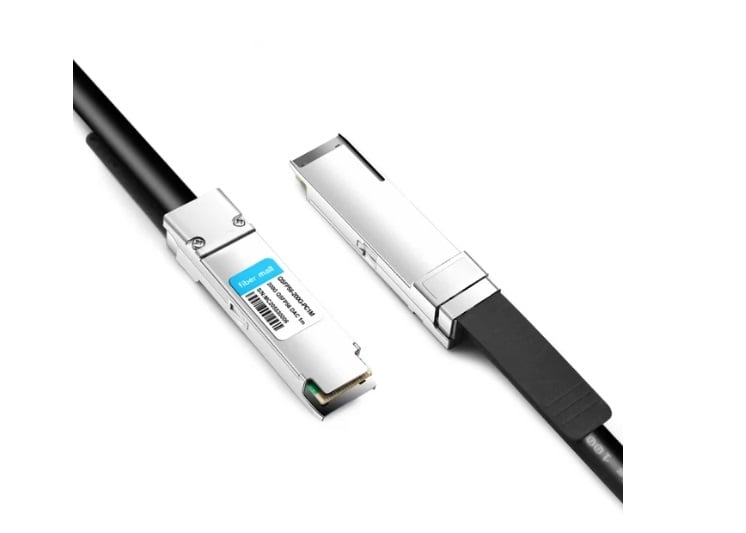
Pros and Cons of Direct Attach Cables
Pros:
- Economical: Digital to analog converters (DACs) typically cost less than optical fiber equivalents, lowering costs.
- Low Delay: They have low signal delay, which is important for high-frequency trading and other applications where latency matters most.
- Simple Installation: DACs are plug-and-play, cutting down on time and difficulty of installing them.
- Great Performance: Being good for short distances, they can transfer data at impressive rates of up to 400Gbps.
Cons:
- Limited Reach: Effective only within a limited distance range, usually around seven meters.
- Bulkiness: These cables are thicker and less flexible than optical fibers, potentially leading to higher cable densities.
- Interference Prone — This may suffer from electromagnetic interference (EMI) that could degrade signals in noisy environments.
- Scalability issues — Not the best choice for future-proofing; might have to be replaced when data center infrastructure changes.
Scenarios Where DAC Cables Are Ideal
DAC cables are advantageous in various situations within a data center:
- Top-of-Rack (ToR) Connections: Connecting servers to a Top-of-Rack switch is best done using them because of short-distance needs.
- Low-Latency Applications: These types of wires are good when used in environments that require extremely low delay, such as financial trading systems and real-time data processing centers.
- High-Density Assemblies: These become useful in dense server racks where it is necessary to simplify cable management by connecting devices directly with each other using short lengths only.
- Cost-Sensitive Deployments: Capital-saving projects should consider deploying them since they help reduce optics expenditures.
- Stable Environments: They can be employed where there is little or no electromagnetic interference to compromise signal integrity.
Cost Efficiency with DAC Cables
DAC cables outperform traditional optical fiber solutions in terms of cost efficiency in many ways. First, they are mostly made of copper, which reduces the cost of materials at their root. They can be created less complexly, which is why its manufacturing process is simpler as well, therefore more affordable. On average, these cables are up to 70% cheaper than fiber optics. Furthermore, since there is no need for optical transceivers when using them, deployment costs are greatly reduced on a general level. These savings are important, especially for short-range connections between data centers that have many cables within limited spaces. In addition, DAC allows for easier installation and maintenance, thereby reducing operational expenses and speeding up network rollouts. Hence, if an entity wants to save money without compromising fast information flow and good network performance, then it should consider adopting DAC cables as they offer excellent value for money.
Future Trends in DAC and AOC Cables
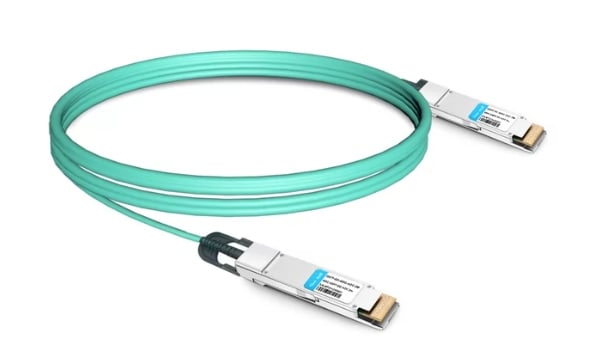
Innovation in Active Optical Cables
Active Optical Cables (AOC) have been one of the most significant network advancements because they greatly improve data-sending capabilities. Signal integrity is improved by innovations made in AOC technologies, while transmission distance is increased and energy efficiency optimized by including sophisticated optical transceivers in AOCs; fast data communication can be done over longer distances than with DAC cables. Furthermore, fiber optic materials and laser technology development also help minimize latency and enhance signal quality. As requirements change within data centers, scalable high-capacity connections must be available. This is where AOCs come into play!
Developments in Direct Attach Cables
In data centers, Direct Attach Cables (DACs) are rapidly changing because of the need for higher bandwidth and better network efficiency. The recent progress in the field of DAC technology aims to boost bandwidth capabilities and make cables lighter, among other things, which enhances the integrity of signals. They do this by integrating innovations like high gauge copper and better shielding methods, which reduce signal loss during faster data transmission while averting electromagnetic interference (EMI). Furthermore, passive and active DACs have been developed so that they can be applied to more network architectures with speeds ranging from 10Gbps up to 400Gbps and beyond. Additionally, the new generation DACs are made from advanced materials using better manufacturing processes, thus ensuring strength and durability and reducing operational costs that result from frequent replacements. These steps, therefore, contribute towards a stronger yet affordable connectivity within high-density data centers.
Anticipated Market Shifts in Cable Technology
The market for cable technology is about to undergo major changes, with higher data rates and more efficient networks being the main drivers. Fiber-optic cables that offer high speeds are increasingly becoming the focus of attention if we’re to rely on Google’s top sources. This is because such cables can support new technologies like 5G, cloud computing, and IoT. Bandwidth and signal integrity are among the reasons why the demand for active optical cables (AOCs), as well as ultra-speed DACs, will grow – they outperform copper cables commonly used in traditional systems. Additionally, in accordance with global environmental concerns along with regulatory standards, cable markets worldwide are shifting towards sustainable energy consumption patterns during production processes, hence making them environmentally friendly too, or green if you like! Such a move calls for the use of ecological materials when making these wires so as not only to reduce carbon emissions but also to cut down on other forms of pollution associated with their manufacture. In conclusion, secure encrypted solutions may gain popularity due to increasing demands for safety in this area while still ensuring no compromise is made on data integrity within highly populated information centers and other critical network structures.
Reference Sources
Frequently Asked Questions (FAQs)
Q: What do DAC and AOC cables do in data centers?
A: DAC (Direct Attach Copper) and AOC (Active Optical Cable) cables are used for high-speed data transfer between network equipment in data centers. These two types of cables can transmit information at breakneck speeds.
Q: How are AOC and DAC cables different from each other?
A: AOC and DAC cables differ because the former uses fiber optic cables to establish connections, while the latter uses copper ones. They also have dissimilar ways of working because one utilizes light signals while the other relays electronic signals.
Q: When should I use an AOC cable instead of a DAC cable?
A: If you want to achieve higher performance levels over longer distances within a data center, you will opt for using active optical cables (AOCs). They are also more flexible and lighter than their counterparts, making them easier to install, especially when space is limited or tight.
Q: Are DAC cables much cheaper than AOC cables?
A: Yes, typically, direct-attach copper (DAC)- -based solutions are less expensive than those that employ active optical technology, mainly because of the material costs involved in manufacturing them, i.e., copper vs. fiber optics.
Q: What are some common types and specifications of DAC and AOC cables?
A: Some examples include 25G SFP28 DAC, 100G QSFP28 DAC, and 200G QSFP56 DAC for Direct Attach Copper (DAC), whereas Active Optical Cables (AOC) consist of 25G SFP28 AOC, 100G QSFP28 AOC, and 200G QSFP56 AOC, amongst others. Moreover, these wires come fitted with connectors that match specific transceiver modules and network devices themselves.
Q: Is it possible to use DAC and AOC cables interchangeably?
A: Although DAC and AOC cables have similar functionality, they aren’t always interchangeable. There are differences in distance limitations and flexibility. The choice between the two types of cables depends on what your data center needs regarding distance and performance.
Q: In what ways does understanding the difference between DAC and AOC cables help my data center setup?
A: Understanding these disparities will enable you to choose wisely based on such factors as distance, cost, and data transfer rate, among others, thus making them work optimally for your data centers’ infrastructure efficiency.
Q: What is a breakout cable, and how is it used with DAC and AOC cables?
A: Breakout cable splits one high-speed connection into multiple lower speed connections. It can be used together with either DAC or AOC cables since they allow for connecting a single high-speed port to many lower-speed devices which provides more flexibility and options for connectivity in network setups.
Q: Do AOC cables use active cable technology?
A: Yes, they do. (The) Active electronics are built into these types of wires, converting electric signals into optic ones back again and enabling longer-range communication distances while offering faster speeds than passive copper wires would be capable of.
Related Products:
-
 QSFP56-200G-PC3M 3m (10ft) 200G QSFP56 to QSFP56 PAM4 Passive Direct Attach Copper Twinax Cable
$80.00
QSFP56-200G-PC3M 3m (10ft) 200G QSFP56 to QSFP56 PAM4 Passive Direct Attach Copper Twinax Cable
$80.00
-
 QSFP56-200G-PC1M 1m (3ft) 200G QSFP56 to QSFP56 PAM4 Passive Direct Attach Copper Twinax Cable
$50.00
QSFP56-200G-PC1M 1m (3ft) 200G QSFP56 to QSFP56 PAM4 Passive Direct Attach Copper Twinax Cable
$50.00
-
 QSFPDD-400G-PC2M 2m (7ft) 400G QSFP-DD to QSFP-DD PAM4 Passive Direct Attach Copper Twinax Cable
$110.00
QSFPDD-400G-PC2M 2m (7ft) 400G QSFP-DD to QSFP-DD PAM4 Passive Direct Attach Copper Twinax Cable
$110.00
-
 QSFPDD-400G-PC3M 3m (10ft) 400G QSFP-DD to QSFP-DD PAM4 Passive Direct Attach Copper Twinax Cable
$155.00
QSFPDD-400G-PC3M 3m (10ft) 400G QSFP-DD to QSFP-DD PAM4 Passive Direct Attach Copper Twinax Cable
$155.00
-
 QSFPDD-2QSFP56-400G-PC2M 2m (7ft) 400G QSFP-DD to 2x200G QSFP56 PAM4 Passive Breakout Direct Attach Copper Cable
$135.00
QSFPDD-2QSFP56-400G-PC2M 2m (7ft) 400G QSFP-DD to 2x200G QSFP56 PAM4 Passive Breakout Direct Attach Copper Cable
$135.00
-
 QDD-2Q56-400G-PC1M 1m (3ft) 400G QSFP-DD to 2x200G QSFP56 PAM4 Passive Breakout Direct Attach Copper Cable
$105.00
QDD-2Q56-400G-PC1M 1m (3ft) 400G QSFP-DD to 2x200G QSFP56 PAM4 Passive Breakout Direct Attach Copper Cable
$105.00
-
 NVIDIA MCA4J80-N003-FLT Compatible 3m (10ft) 800G Twin-port 2x400G OSFP to 2x400G OSFP InfiniBand NDR Active Copper Cable, Flat top on one end and Flat top on the other
$600.00
NVIDIA MCA4J80-N003-FLT Compatible 3m (10ft) 800G Twin-port 2x400G OSFP to 2x400G OSFP InfiniBand NDR Active Copper Cable, Flat top on one end and Flat top on the other
$600.00
-
 NVIDIA MCA7J65-N004 Compatible 4m (13ft) 800G Twin-port OSFP to 2x400G QSFP112 InfiniBand NDR Breakout Active Copper Cable
$800.00
NVIDIA MCA7J65-N004 Compatible 4m (13ft) 800G Twin-port OSFP to 2x400G QSFP112 InfiniBand NDR Breakout Active Copper Cable
$800.00
-
 NVIDIA MCP7Y40-N001 Compatible 1m (3ft) 800G InfiniBand NDR Twin-port OSFP to 4x200G QSFP112 Breakout DAC
$165.00
NVIDIA MCP7Y40-N001 Compatible 1m (3ft) 800G InfiniBand NDR Twin-port OSFP to 4x200G QSFP112 Breakout DAC
$165.00
-
 NVIDIA MCP7Y00-N001 Compatible 1m (3ft) 800Gb Twin-port OSFP to 2x400G OSFP InfiniBand NDR Breakout Direct Attach Copper Cable
$160.00
NVIDIA MCP7Y00-N001 Compatible 1m (3ft) 800Gb Twin-port OSFP to 2x400G OSFP InfiniBand NDR Breakout Direct Attach Copper Cable
$160.00
-
 QSFP28-100G-AOC-2M 2m (7ft) 100G QSFP28 to QSFP28 Active Optical Cable
$86.00
QSFP28-100G-AOC-2M 2m (7ft) 100G QSFP28 to QSFP28 Active Optical Cable
$86.00
-
 QSFP28-100G-AOC-5M 5m (16ft) 100G QSFP28 to QSFP28 Active Optical Cable
$90.00
QSFP28-100G-AOC-5M 5m (16ft) 100G QSFP28 to QSFP28 Active Optical Cable
$90.00
-
 QSFP28-100G-AOC-10M 10m (33ft) 100G QSFP28 to QSFP28 Active Optical Cable
$98.00
QSFP28-100G-AOC-10M 10m (33ft) 100G QSFP28 to QSFP28 Active Optical Cable
$98.00
-
 QSFP56-200G-AOC-2M 2m (7ft) 200G QSFP56 to QSFP56 Active Optical Cable
$340.00
QSFP56-200G-AOC-2M 2m (7ft) 200G QSFP56 to QSFP56 Active Optical Cable
$340.00
-
 QSFP56-200G-AOC-3M 3m (10ft) 200G QSFP56 to QSFP56 Active Optical Cable
$350.00
QSFP56-200G-AOC-3M 3m (10ft) 200G QSFP56 to QSFP56 Active Optical Cable
$350.00
-
 QSFP56-200G-AOC-50M 50m (164ft) 200G QSFP56 to QSFP56 Active Optical Cable
$415.00
QSFP56-200G-AOC-50M 50m (164ft) 200G QSFP56 to QSFP56 Active Optical Cable
$415.00
-
 QSFP-DD-400G-AOC-3M 3m (10ft) 400G QSFP-DD to QSFP-DD Active Optical Cable
$665.00
QSFP-DD-400G-AOC-3M 3m (10ft) 400G QSFP-DD to QSFP-DD Active Optical Cable
$665.00
-
 QSFP-DD-400G-AOC-10M 10m (33ft) 400G QSFP-DD to QSFP-DD Active Optical Cable
$690.00
QSFP-DD-400G-AOC-10M 10m (33ft) 400G QSFP-DD to QSFP-DD Active Optical Cable
$690.00
-
 QSFP-DD-400G-AOC-20M 20m (66ft) 400G QSFP-DD to QSFP-DD Active Optical Cable
$725.00
QSFP-DD-400G-AOC-20M 20m (66ft) 400G QSFP-DD to QSFP-DD Active Optical Cable
$725.00
-
 QSFP-DD-800G-AOC-7M 7m (23ft) 800G QSFP-DD to QSFP-DD Active Optical Cable
$2740.00
QSFP-DD-800G-AOC-7M 7m (23ft) 800G QSFP-DD to QSFP-DD Active Optical Cable
$2740.00

